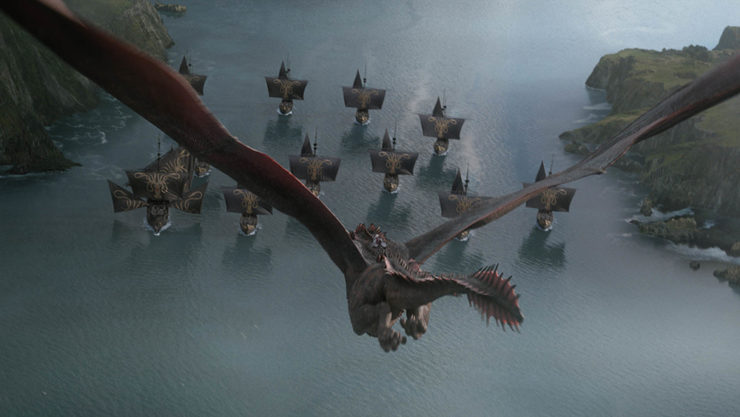In the last episode of Game of Thrones, some things went down. This article will be about one of those things. So spoiler warnings, people.
Last chance to turn back.
Ready?
Okay. So, as you may recall, a ship-borne Euron Greyjoy surprises a dragon-borne Dany, shooting one of her dragons—Rhaegal, RIP—with a deck-mounted rapid-fire torsion weapon that the show calls a “scorpion.” Euron’s bolts cut through the beast, killing it, before a sequence of further shots from his ships blasts her fleet to splinters.
I have thoughts.
First, screw Three-eyed Raven “Nut” Bran Stark. Dude sees everything but speaks nothing.
Second, screw Dany for somehow managing to be surprised by a fleet of ships despite the fact that she has superior range of view from the back of a flying dragon. Seriously? She and Jon are just The Worst when it comes to using their heads. Gotta say, I’m fast becoming #TeamNoneOfTheseSchmucks.
Third, I can actually accept the possibility of a rapid-fire ballista. Building one is a significant engineering problem, but it’s hardly insurmountable. Philo of Byzantium actually described such a device in his work Mechanike syntaxis (he called the device a polybolos, meaning ‘thrower of multiple things’) in the 3rd century BC. So I’ll take it. No problem there.
Fourth …well, let’s talk projectile ballistics.
The path of a projectile—in our case, a scorpion bolt—is affected by some major variables, including the initial velocity it has, the air resistance it encounters, and the pull of gravity upon it. And yeah, I know Game of Thrones is fantasy, but I’ve seen no indications that Westeros has anything but Earth-like gravity and atmospheric composition. These facts, plus the relatively calm weather conditions for the event in question and the distance between Euron and Dany, will simplify our calculations considerably.
Sorry to bring high school maths back for y’all, but for simplicity’s sake the end result of all this will be a path that looks like a parabola: a projectile ought to make a rather lovely arc between an initial launching point and a final landing point.
You may already be seeing the problem.
Buy the Book


A Hero Born
See, those scorpion bolts went straight. I mean, really straight. Their trajectory was so flat that Euron was using a fixed “iron” sight to take aim. Since a projectile under the influence of gravity cannot have a flat trajectory, the only explanation for such a seemingly straight shot would be that its parabolic arc is so wide that within the range covered it appears to be flat. It’s rather like how over short distances the earth appears to be flat, but that’s only because we’re seeing such a small section of a really wide curvature.
In other words, if it hadn’t hit the neck of a flying dragon, Euron’s bolt would have gone really, really far.
How far?
Let’s have some fun with numbers!
I’m eyeballing things here, but I’d estimate Dany is about 1,000 meters away from Euron. It’s probably more, given the fact that she didn’t see his damn fleet at all, but I’ll roll with this. And of course Euron needs to hit a moving target. I don’t have the exact velocity of a dragon at hand just now, but I do know that the airspeed velocity of an unladen European swallow is about 11 meters per second. So I’ll guess Rhaegal is cruising around 5 m/s. Seems fair.
Before we get to anything else, I’ve got to give some props to some impressive shooting on Euron’s part. An object moving 5 m/s at a range of 1,000 meters is damn hard to hit even with modern, fully adjustable optical sights. Plus, you know, that scorpion is hard-mounted to the deck of a vessel that on the open sea will be experiencing pitch, yaw, roll, heave, surge, and sway. So yeah, it’s (impossibly) impressive shooting.
Ah, you might say, but this is a big object. That makes it easier.
True, true.
To continue, then, let’s see what that first hit tells us. Euron clearly had this moving target in his non-adjustable sights, because he hit it. Now, I’m gonna reckon that Rhaegal’s neck is about 5 meters thick from top to bottom, and we know that this target is moving horizontally (5 m/s) and that the bolt itself will drop from whatever he’s aiming at. Given that he hit Rhaegal smack dab in the middle of its throat, that drop can’t be much more than 2.5 meters.
In other words, he would need to be aiming for the very nose of the beast, and the bolt would need to cover the 1,000 meter distance in about half a second.
The bolt, therefore, would need to have an initial velocity of about 2,000 m/s.
By comparison, a modern sniper rifle propels a bullet around 800 to 1,000 m/s (howdy, Fortnite fans!).
Oh, remember that parabola? Having the projectile drop just 2.5 meters over its first 1,000 meters of travel means it’s a wide one. If we figure that the angle, from Euron’s perspective, between the sea and Rhaegal is about 20 degrees, we can use our initial velocity to trace out that parabola mathematically.
I’m just a lowly medievalist here, folks, but I’m calculating that Euron’s bolt, if it hadn’t hit the dragon, would have reached a maximum elevation of around 14 miles above sea level before it nosed back down to earth. That’s, um, around twice the cruising altitude of most commercial airliners.
And sure, there’s some wiggle room to my calculations. Atmospheric conditions are one of those major variables, after all, and while the weather was great when Euron pulled the trigger, if his bolt hadn’t hit the dragon a lot could’ve happened to it during the—checks notes—more than two minutes it would’ve been airborne after he released it, during which time—checks notes again—it would’ve traveled about 163 miles. A missed shot would’ve passed through weather systems.
Probably this is all academic. It doesn’t matter how many damn torsion arms you put on one, no medieval or quasi-medieval ballistics engine can manage to launch a projectile at hypersonic speeds. Alas.
Oh there he goes again, you might be thinking, with his nonsensical demands that the fantasy of Game of Thrones should better reflect the reality of our history.
Well… yeah, I guess maybe I’m doing that a little. But there’s actually a flip-side to all this. I saw more than one complaint online from folks who doubted that bolts from a ballista could actually blow through dragons and ships in the ways depicted. Knowing something about real ballistae, I thought the same myself when I first watched the episode.
But you know what? I’ve got to give credit where it is due now that I’ve seen the numbers. A bolt cutting through the air at friggin’ hypersonic speed would indeed obliterate anything in its path.
So all’s well that ends well…
…except …damnit, Jon …you pet your direwolf before you go. Always.
 Michael Livingston is a Professor of Medieval Culture at The Citadel who has written extensively both on medieval history and on modern medievalism. His historical fantasy trilogy set in Ancient Rome, The Shards of Heaven, The Gates of Hell, and The Realms of God, is available from Tor Books. His new fantasy novella “Black Crow, White Snow” was released on Friday, May 3rd as an Audible Original.
Michael Livingston is a Professor of Medieval Culture at The Citadel who has written extensively both on medieval history and on modern medievalism. His historical fantasy trilogy set in Ancient Rome, The Shards of Heaven, The Gates of Hell, and The Realms of God, is available from Tor Books. His new fantasy novella “Black Crow, White Snow” was released on Friday, May 3rd as an Audible Original.










